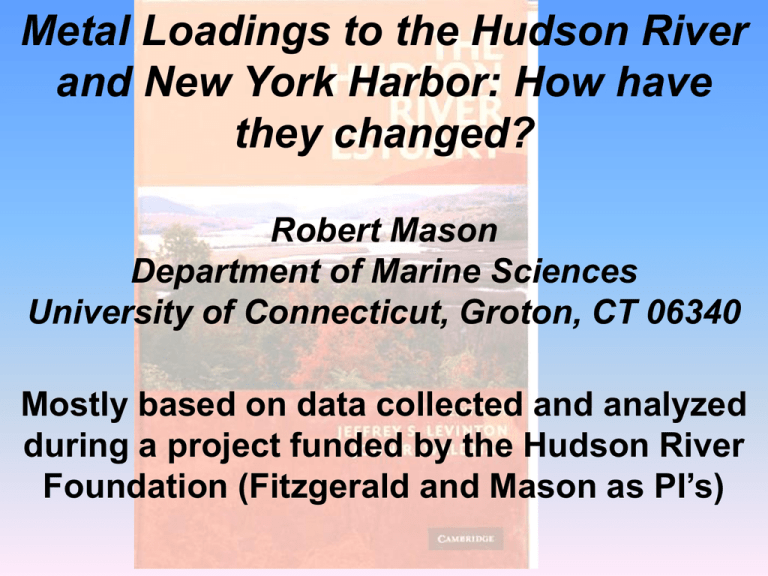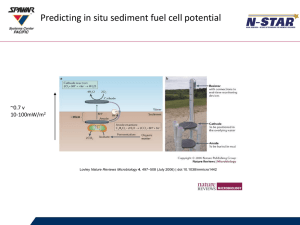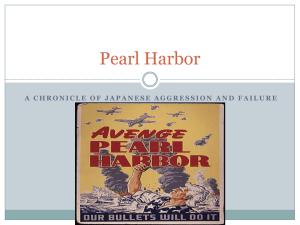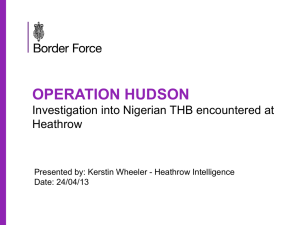the PowerPoint presentation
advertisement

Metal Loadings to the Hudson River and New York Harbor: How have they changed? Robert Mason Department of Marine Sciences University of Connecticut, Groton, CT 06340 Mostly based on data collected and analyzed during a project funded by the Hudson River Foundation (Fitzgerald and Mason as PI’s) Outline • Why we care about metals in the Hudson? • Sediment Data • Water Data – Factors controlling distributions in the upper estuary and NY/NJ Harbor • Water Data – Changes over time • Mass Balances for the Metals - Sources to the Harbor, and major sinks Levington et al 2008 Metal Toxicity? 1) Impact is on lower food chain organisms for most metals as bioaccumulation is greatest for plankton. In the Hudson, Cd is the most important example as there are known point source contamination (e.g. Foundry Cove) that been shown to cause toxicity. However, organisms were able to generate resistance to the Cd. 2) Toxicity of highly bioaccumlative compounds is manifest in the higher level consumers and toxicity to plankton may not occur. Example is methylmercury which has most impact for higher food chain consumers (humans, mammals and birds) that feed on piscivorous fish EPA A number of species exceed the EPA recommended value for mercury (assuming all as methylmercury) Health of the Harbor report Gobeille et al., 2006 People consuming local fish have higher mercury levels than those who do not . Levels found in Hudson River similar to that for other ecosystems where people eat local fish Levels below the EPA suggested reference level of 5.8 ng/mL. Gobeille et al., 2006 Sediment Concentrations Levels of metals in sediments of the Hudson River are elevated above other US estuaries and higher than background concentrations Taken from Bopp et al., Ch 24 Changes in Sediment Metal Conc (ppm) between 1960’s & 1990’s Metal Pb mid-60’s Pb 1990’s %Decrease Cd mid-60’s Cd 1990’s %Decrease Cu mid-60’s Cu 1990’s %Decrease Zn mid-60’s Zn 1990’s %Decrease Cr mid-60’s Cr 1990’s %Decrease Hg mid-60’s Hg 1990’s %Decrease NY/NJ Harbor 235 126 46 5.6 1.1 80 268 122 54 352 232 34 286 116 59 3.4 1.6 53 Jamaica Arthur Bay Kill 336 81 76 10.9 1.7 84 362 93 74 608 210 65 225 102 55 2.3 0.45 80 398 211 47 21.3 2.9 86 1395 312 78 1045 404 61 325 166 49 20 4.94 75 Newark Hacken- Passaic Bay sack R R 373 142 62 11 1.95 82 342 160 53 717 265 63 343 109 68 8.1 3 63 240 132 45 741 327 56 968 568 307 46 12.4 4.2 66 248 120 52 1052 523 50 10.8 3.6 67 7.77 3.64 53 12.48 1.83 85 Changes in Sediment Metal Conc (ppm) between 1960’s & 1990’s Metal Pb mid-60’s Pb 1990’s %Decrease Cd mid-60’s Cd 1990’s %Decrease Cu mid-60’s Cu 1990’s %Decrease Zn mid-60’s Zn 1990’s %Decrease Cr mid-60’s Cr 1990’s %Decrease Hg mid-60’s Hg 1990’s %Decrease Main, Batten Main, above Dam Kill Lock 2 Mohawk Main at Main, at River Troy Kingston 1560 69 96 46 45 2 512 42 92 68 9.1 87 411 42 90 118 44 63 115.0 5.7 22.4 0.5 10.6 3.4 30 74 121 0.6 89 42 <0.5 >98 31 1.2 Increase 132 2.6 75 508 0.03 99 76 31 74 1100 108 90 1440 154 89 8.93 0.56 94 30 29 1026 265 74 26 21 19 22 29 662 79 88 - 43 67 103 59 88 1056 224 79 27 64 308 127 59 195 74 62 0.93 0.19 80 0.2 52 0.45 0.13 71 1.95 0.42 78 From Bopp et al., Ch 24 Sediment Concentration Changes • For most metals and locations, there has been a dramatic decrease in concentration between 1960’s and 1990’s • In mainstem, no trend in concentration with distance • Changes somewhat less dramatic in the lower estuary • Concentrations still elevated above background for many metals. • How does this impact the ecosystem? Levinton & Pochron, 2008 Metal Main, Batten above Dam Kill Main, Mohawk Main at Main, at Relative change in fish Lock 2 River Troy Kingston concentration less HRM ~195 HMR ~165 Hg mid-60’s 8.93 Hg 1990’s 0.56 %Decrease 94 0.2 HRM 150 HRM ~90 0.45 1.95 0.93 0.13 0.42 0.19 71 78 80 than that of sediment for Hg. Also fish do not track sediment concentration Assessment of Water Column Data Sources of Data Data summarized was derived from a variety of literature sources and databases. Evaluated for appropriateness of the analytical methods and complete presentation of quality assurance/quality control (QA/QC) procedures and results. Large databases included CARP (Contaminant Assessment and Reduction Project), EMAP (Environmental Monitoring and Assessment Project), and data from regulatory agencies (e.g., NYSDEC State Waters Monitoring Section [SWMS] and Division of Water). Most published studies have reported surface and deep water concentrations of metals (Hg, Cd, Cu, Fe, Ni, Zn, Ag, and Pb) in the lower Hudson (south of Newburg; ~25 to 100 km north of the Battery) and the estuarine turbidity maximum (ETM; south of the Harlem River; ~ 4 to 25 km). Hudson River Estuary Waterford ••Cohoes • Glenmont Hudson River Watershed 0 Metal Ni Cu Zn Cd Hg Pb Atomic Mass 1 ug/L = x nM 1ppm = x nmol/g 58.7 63.5 65.4 112.4 200.6 207.2 • Kingston-Poughkeepsie 10 20 30 Km NY/NJ Harbor 17.0 15.7 15.3 8.9 5.0 4.8 Water - Middle & Upper Hudson 70 60 50 40 30 20 10 0 50 90 total dissolved % particulate 80 70 60 40 50 30 40 20 30 20 10 0 t s d ie on oe for ps h r m e e o t en ke C Gl Wa gh u Po 10 0 90 80 160 140 120 100 80 60 40 20 0 70 400 100 60 50 40 30 20 10 0 Zn 1993-2006 300 Zn (nM) Ni (nM) 60 Ni 1993-2006 100 100 particulate fraction (%) 80 Cu 1993-2006 TSS 90 80 70 60 200 50 40 100 30 20 10 0 t s d ie on oe for ps h r m e e o t en ke C Gl Wa gh u Po 0 TSS (mg l-1) 90 80 70 100 400 350 300 250 200 Cu (nM) Pb 1993-2006 particulate fraction (%) 140 120 100 80 60 40 20 12 10 8 6 4 2 0 particulate fraction (%) Pb (nM) (SWMS; collected 1993-2006; mean ± SD) Water - Middle & Upper Hudson (CARP; collected 1999-2001; mean ± SD) total dissolved % particulate 90 150 80 100 70 50 60 14 12 10 8 6 4 2 0 50 . s d sie gh or oe f p u r h e o e Co -P ate hk n W g o u st Po ng i K 40 30 20 10 0 2.00 Cd 1999-2001 100 90 1.50 80 1.00 70 0.25 60 0.20 50 40 0.15 30 0.10 20 0.05 10 0.00 0 h. s d ie g or oe f ps u r h e o e Co -P ate hk n W g o u st Po ng i K particulate fraction (%) Hg 1999-2001 Cd (nM) Hg (pM) 200 2.50 100 particulate fraction (%) 250 TSS - Upper Hudson/Sources of Metals (SWMS; collected 1993-2006; mean ± SE) 30 12 10 8 20 6 15 4 10 2 5 2 0 0 0 25 8 30 6 20 4 20 15 6 10 4 2 0 t s d ie on oe for ps h r m e e o e t en C hk Gl Wa ug o P 250 Zn 1993-2006 5 0 Zn (µmol g-1) suspended particle metal/ Fe 0 25 Ni/Fe (x 10-4) Ni (µmol g-1) 8 suspended particle concentration 10 30 Ni 1993-2006 10 40 Cu/Fe (x 10-4) 25 Cu (µmol g-1) 10 12 50 Cu 1993-2006 Pb/Fe (x 10-4) Pb (µmol g-1) Pb 1993-2006 200 20 150 15 100 10 5 0 t s d ie on oe for ps h r m e e o e t en C hk Gl Wa ug o P 50 0 Zn/Fe (x 10-4) 12 TSS - Upper Hudson Sources of Hg (CARP & SWMS; collected 1999-2001; mean ± SE) 200 200 (suspended particle Hg:Fe ratios) (suspended particle concentrations) 180 180 160 Total Hg (pM) Total Hg (pM) 160 Poughkeepsie (2.1) 140 120 100 Cohoes (10.2) 80 120 100 -6 Cohoes (11.6 x 10 ) 80 Waterford (6.8) 60 -6 Poughkeepsie (3.0 x 10 ) 140 -6 Waterford (9.2 x 10 ) 60 40 40 0 10 20 30 40 50 TSS (mg L-1) 60 70 80 0 10 20 30 40 total Fe (µM) 50 60 Spatial/seasonal MMHg distributions (CARP; collected 1999-2000; mean ± SE) 0.6 2.2 3 0.3 2 0.2 Filtered MMHg (pM) Filtered MMHg (pM) 4 0.4 spring 1999 fall 1999 spring 2000 summer 2000 2.0 diss. MMHg/HgT (%) MMHg diss. MMHg/HgT 0.5 5 0.5 Waterford 0.4 ETM 0.3 0.2 1 0.1 0.1 0.0 0 . rd on sie ep ds r fo ep ke u e e h t k H g Wa gh er ou u P w o n P Lo sto g n Ki M ET 0.0 0 50 100 150 Distance (km) 200 250 Summary middle and upper Hudson Average total (filtered + particulate) concentrations of Hg (58 to 130 pM), Cu, Ni, Zn, and total suspended solids (TSS) in surface waters are highest at Poughkeepsie. Cd (0.97 to 1.3 nM) and Pb were more uniformly distributed in the middle and upper Hudson. Fe-normalized suspended particle concentrations of Hg, Cd, Pb, Cu, Ni, and Zn were elevated in the upper Hudson at Waterford and Cohoes as compared to Poughkeepsie, indicating watershed sources of trace metals. MMHg in the middle and upper Hudson is likely derived/connected to net production in the Hudson River watershed. Hudson River - Water (Lower Hudson and ETM) (CARP; collected 1999-2001; mean ± SE) 2.2 2.0 1.8 1.6 1.4 1.2 200 total HgT filtered HgT 180 160 140 1.0 Cd (nM) 120 Hg (pM) total Cd filtered Cd 100 80 60 0.8 0.6 0.4 40 0.2 20 0 ie p. on ord ee ps ds k e erf u e h t k H g a h r u W ug we -Po n Po Lo o t gs Kin M ET 0.0 . n rd sie ep so e p rfo d k e e u e h t k h rH ug Wa ug we -Po n Po Lo to gs n i K M ET Summary Lower Hudson and ETM In the estuarine turbidity maximum (ETM), average total Cd concentrations (0.74 to 1.2 nM, surface waters) are similar to the middle and upper Hudson sites, while average total Hg (54 to 1110 pM, surface and bottom waters) is elevated as compared to the rest of the upper Hudson. The filtered fraction of Cd increases dramatically with salinity (83 to 120% of total Cd) in the lower Hudson River, and higher total Hg and Cd levels are associated with spring high flow periods. Average surface water suspended particle concentrations of Hg (2.20 to 3.54 nmol g-1) and Cd (5.45 to 12.6 nmol g-1) are largely overlapping between the ETM and lower Hudson. ETM and upper Hudson suspended particle metals concentrations are elevated as compared to the middle Hudson (Poughkeepsie), indicating sources of metals in both regions. Major Rivers – NY/NJ Harbor 180 25 20 Hg (pM) 160 140 15 120 100 80 10 60 40 5 20 0 l . t t rf rf al uth -tida tR su n-bo su h-bo -tid s o a n h . m id ita ta ut mid ut rE ck . m ari Rar mo . mo ss. we R . o Ha ack L ss ss Pa H Pa Pa 0 2.0 1.8 1.6 1.4 70 total Cd filtered Cd suspended particle Cd 1.2 60 50 40 1.0 0.8 0.6 30 20 0.4 0.2 0.0 t rf rf al al ot th R. st ou d-tid -su an-b -su th-bo d-tid a n h m t i i E a t . r rit Rari ou ou . m ck . m we Ra . m s. m ass o Ha ack s L s s P H Pa Pa 10 0 suspended particle Cd (nmol g-1) 30 total HgT filtered HgT suspended particle Hg Cd (nM) 1200 1000 800 600 400 suspended particle Hg (nmol g-1) (CARP; mean ± SE; collected 1999-2001) Summary - Rivers Average total Hg (145 and 433 pM, surface and bottom waters) and Cd (0.97 and 1.35 nM) concentrations at the mouth of the Passaic River were elevated as compared to the Hudson ETM, while only total Hg (109 pM) was elevated at the mouth of the Hackensack River. Concentrations in the lower East River and the Raritan River were similar to levels in the Hudson ETM. Average suspended particle Hg (9.8 to 20.8 nmol g-1) and Cd (9.6 to 49.2 nmol g-1) concentrations were elevated in both the Hackensack and Passaic as compared to the Hudson, although suspended particle Cd was less near the mouths of rivers. NY/NJ Harbor - Water (CARP; collected 1999-2001; mean ± SD) 1.0 Hg (pM) 60 60 40 20 0 ay rbor Bay rbor Bay ight B B a a ark er H ritan er H aica NY w Ra Low Jam Ne Upp 40 20 0 total filtered % particulate TSS 0.8 80 60 0.6 40 0.4 0.2 0.0 ay rbor Bay rbor Bay ight B B a a ark er H ritan er H aica NY w Ra Low Jam Ne Upp 50 100 40 30 20 20 10 0 0 TSS (mg l -1) 80 Cd particulate (%) 1.2 Cd (nM) Hg 100 particulate (%) 400 300 200 100 NY/NJ Harbor Water (Balcom et al. 2008; collected 2002-2003; mean ± SD) total filtered % particulate TSS MMHg (pM) 1.2 1.0 80 60 0.8 0.6 0.4 40 ay rbor Bay rbor Bay ight B rk r Ha itan r Ha aica Y B a N r w e e Ra Low Jam Ne Upp 170 160 40 30 20 20 10 0 0 0.2 0.0 180 100 TSS (mg l -1) MMHg particulate (%) 2.2 2.0 1.8 NY/NJ Harbor - Water 40 0.5 20 0.0 0 25 60 20 40 15 10 20 5 total filtered % particulate 25 60 20 15 10 40 20 5 0 r r k y y y Ba rbo Ba rbo Ba oo rk r Ha itan r Ha aica dy H a r w e e Ra Low Jam -San Ne Upp y wa ka c Ro 50 100 80 0 45 14 Zn TSS 40 35 10 30 8 25 20 6 15 4 10 5 0 12 0 r r k y y y oo Ba rbo Ba rbo Ba rk r Ha itan r Ha aica dy H a r w e e Ra Low Jam -San Ne Upp y wa ka c Ro 2 0 TSS (mg L-1) Ni 0 Zn (nM) 40 30 80 particulate (%) 60 100 Cu 30 Cu (nM) 80 particulate (%) 35 1.0 35 40 100 Pb particulate (%) 40.0 35.0 30.0 25.0 20.0 15.0 10.0 5.0 Ni (nM) Pb (nM) (Paulson, 2005; collected 1999; mean ± SD) Concentration (nM) Temporal Comparison Water 450 400 350 300 250 200 150 100 50 1974/1975 1999 Filtered Metals Klinkhammer and Bender (1981) collected 1974-1975 NY Bight Paulson (2005) collected 1999 Rockaway-Sandy Hook transect 14 12 10 8 6 4 2 0 Cd Concentration (nM) (mean ± SD) 450 400 350 300 250 200 150 100 50 Cu 1974/1975 1999 Ni Zn Total Metals Sañudo-Wilhelmy and Gill (1999) reported a similar decrease in dissolved metals for the Hudson ETM and Lower Harbor between 1974/1975 and 1995/1997. 16 14 12 10 8 6 4 2 0 Cd Cu Ni Metal Zn NY/NJ Harbor – Recent Sediment (CARP, collected 1999-2001; EMAP, surface sediment collected 1998; mean ± SD) 40 35 30 18 16 14 12 10 8 6 4 2 0 Hg ay rbor Bay rbor Bay ight B rk r Ha itan r Ha aica Y B a N r w e e Ra Low Jam Ne Upp Cd (nmol g-1) Hg (nmol g-1) suspended particles sediment sediment 50 45 40 35 30 25 Cd 20 15 10 5 0 ay rbor Bay rbor Bay ight B rk r Ha itan r Ha aica Y B a N r w e e Ra Low Jam Ne Upp Circles are data not included in the averages as considered outliers NY/NJ Harbor - Recent Sediment (Balcom et al., 2008 and Hammerschmidt et al., 2008 suspended particles and surface sediment collected 2002-2003; mean ± SD) suspended particle sediment suspended particle MMHg (pmol g -1) sediment 60 55 50 45 40 35 30 25 20 15 10 5 0 MMHg ay rbor Bay rbor Bay ight B B a a ark er H ritan er H aica NY w Ra Low Jam Ne Upp Circles - data not included in the averages NY/NJ Harbor – Recent Sediment (Paulson, 2005, suspended particles collected 1999; EMAP, surface sediment collected 1998 and 1993-1994; mean ± SD) suspended particles sediment sediment suspended particles 5 10 Pb 9 Cu (µmol g -1) Pb (µmol g-1) 4 3 2 3 2 1 0 0 1.6 10 Ni Zn 8 Zn (umol g-1) 1.4 Ni (µmol g-1) 8 4 1 1.8 Cu 1.2 1.0 0.8 0.6 0.4 6 4 2 0.2 0.0 0 t r r k y y y Ba arbo n Ba arbo a Ba Hoo Bigh k r H rita r H aic dy NY wa er e n Ne Upp Ra Low Jam -Sa y a aw ck Ro t r r k y y y Ba arbo n Ba arbo a Ba Hoo Bigh k r H rita r H aic dy NY wa er e n Ne Upp Ra Low Jam -Sa y a aw ck Ro Circles - data not included in the averages ETM and NY/NJ Harbor - Ratios (Paulson, 2005 and Feng et al., 2002 - suspended particles collected 1994-1999 ; EMAP, surface sediment collected 1998 and 1993-1994; mean ± SE) 70 70 Cu Pb Cu/Fe and Cu/Al (x 10 -4) Pb/Fe and Pb/Al (x 10 -4) 80 60 50 40 30 20 10 60 50 40 30 20 10 0 0 25 250 20 15 10 5 0 ) ) ht or or ay ok km km Ho Big arb arb nB a H H y (10 (4 Y t r r N ri nd M M pe we Ra Sa ET ET Up Lo k.c Ro Zn/Fe and Zn/Al (x 10 -4) Ni/Fe and Ni/Al (x 10 -4) Ni 200 suspended particle metal/Fe sediment metal/Fe suspended particle metal/Al sediment metal/Al Zn 150 100 50 0 ) ) ht or or ay ok km km Ho Big arb arb nB a H H y (10 (4 Y t r r N ri nd M M pe we Ra Sa ET ET Up Lo k.c Ro ETM and NY/NJ Harbor - Ratios (Paulson, 2005 and Feng et al., 2002 - suspended particles collected 1994-1999 ; EMAP, surface sediment collected 1998; mean ± SE) suspended particle metal/Fe sediment metal/Fe suspended particle metal/Al sediment metal/Al water POC sediment siltclay sediment TOC 80 0.20 60 0.15 40 0.10 0.05 0.00 ) r ) ht or ay ok km rbo km Ho Big arb nB Ha H a y (10 (4 Y t i r r d N r n M M pe we Ra Sa ET ET Up Lo k.c Ro 20 0 0.50 0.45 2000 1500 1000 500 Cd/Fe and Cd/Al (x 10 -4) Hg/Fe and Hg/Al (x 10-4) 0.25 2500 TOC (µmol g-1) 100 Hg POC (µM) and siltclay (%) 0.30 Cd 0.40 0.35 0.30 0.25 0.20 0.15 0.10 0.05 0 0.00 ) r ) ht or ay ok km rbo km Ho Big arb nB Ha H a y (10 (4 Y t i r r d N r n M M pe we Ra Sa ET ET Up Lo k.c Ro Summary – NY/NJ Harbor Regional average trace metal concentrations of Hg (3.2 to 166 pM) and Cd (0.19 to 0.90 nM) in NY/NJ Harbor were generally elevated and more variable near the input of major rivers in Newark Bay and the Upper Harbor, roughly corresponding with elevated TSS levels. Harbor Hg and Pb were mainly in the particulate phase, while Cd, Cu, and Ni have more metal in the dissolved fraction at elevated Harbor salinities. Over 25 years (1974 to 1999), average dissolved metals concentrations (surface and deep) in the Lower Harbor and NY Bight region were reduced by 85 to 90%. Summary – NY/NJ Harbor (continued) There was good agreement between average suspended particle concentrations of Hg (1.1 to 8.7 nmol g-1), Cd (3.1 to 13.2 nmol g-1), and other metals with surface sediment concentrations in the Harbor, while suspended particle concentrations in the ETM are known to be elevated as compared to sediments (Feng et al., 2002). However, Al- and Fe-normalized suspended particle metal concentrations were reduced in the Hudson ETM and elevated in Raritan Bay and at the Rockaway-Sandy Hook transect suggesting metals enrichment due to association with fine particulate material or particulate organic matter. Budget sources – percent inputs (mean ± SE) Hg - 3100 moles y-1 69±27% 2±4% 2±0.2% 23±7% 5±0.5% Rivers East River WPCFs Atm. Deposition Benthic flux Cd - 25 K moles y-1 MMHg - 14 moles y-1 59±24% 57±26% 4±15% 26±3% 4±1% 9±1% 8±1% 21±11% 10±1% 2±0.3% Budget sources – percent inputs (mean ± SE) Pb - 850 K moles y-1 Ni - 1700 K moles y-1 38±21% 88±8% 0.1±0.1% 4±1% 25±4% 6±0.1% 19±27% 16±0.4% 1±1% 2±0.2% Cu - 2800 K moles y-1 Zn - 7100 K moles y-1 60±23% 39±9% 6±2% 11±2% 21±0.5% 19±2% 11±28% 2±0.3% 23±0.4% Rivers East River WPCFs Atm. Deposition Benthic flux 8% Temporal Comparison of Metal Inputs (mean ± SE or range) Reference Sampling Period Cd (K moles y-1) Ni (K moles y-1) Cu (K moles y1) Zn (K moles y-1) This Study ~ 2000 - 2006 25 ± 7.4 1700 ± 580 2800 ± 660 7100 ± 2100 Klinkhammer & Bender (1981) April 1974 280 - 590 4500 - 9500 5200 10000 11100 28300 (enhancement) (11 to 24 x) (2.5 to 5.5 x) (2 to 3.5 x) (1.5 to 4 x) October 1975 190 - 500 3400 - 7500 4000 - 8400 7000 - 15100 (enhancement) (8 to 20 x) (2 to 4.5 x) (1.5 to 3 x) (1 to 2 x) Decrease most dramatic for Cd - >90% reduction in inputs. Other metals show more modest reductions over time. Summary – Mass Balances Current annual loadings (~2000 to 2006) to NY/NJ Harbor estimated for Hg (3100 mol y-1), MMHg (37 mol y-1), Cd (25 Kmol y-1), Pb (850 Kmol y-1), Ni (1700 Kmol y-1), Cu (2800 Kmol y-1), Zn (7100 Kmol y-1) The majority of inputs are from rivers (38 to 88% of totals). River fluxes of metals were estimated independently using a Hudson sediment delivery flux (8.12 ± 3.25 x 1011 g y-1; Wall et al. [2008] and HydroQual [2003]) and mean suspended particle metals concentrations in the middle/lower Hudson. These estimates agreed well with the annual loadings shown above. Total inputs are significantly decreased for Cd (8 to 42x), Ni (2 to 5.5x), Cu (1.5 to 3.5x), and Zn (1 to 4x) since the mid 1970s (25 to 30 years). The relative contribution of metals from sewage has decreased. Hg inputs are likely to have declined by about a factor of 3-5 since the mid-1960s. Conclusions There is a need for high quality time series measurements of filtered and suspended particle metals concentrations, as well as important ancillary parameters (e.g., POC), in the waters of the Hudson River and NY/NJ Harbor. The decline in metals concentrations in the waters of NY/NJ Harbor since the mid-1970s was established by a comparison between adjacent regions. The time series of measurements is incomplete for any one region of the Harbor. Limited measurements (1999-2001) of Hg and Cd concentrations in the middle and upper Hudson, major regions of the Harbor, and the East River, with almost no data on suspended particle concentrations. Conclusions (continued) The sediment-water fluxes of most trace metals has not been measured in NY/NJ Harbor, and are needed considering the importance of this source term in some mass balances (e.g., MMHg) Bulk (wet and dry) atmospheric deposition measurements are limited for most metals in the Harbor region, and are important to mass balances since atmospheric deposition of metals and subsequent yield from watersheds accounts for a substantial portion of the fluxes of metals in rivers. We hypothesize that much of the MMHg in NY/NJ Harbor is likely connected to net production in the Hudson River watershed, and that there is limited MMHg input from river sediments. Seasonal distributions of Hg (CARP; collected 1999-2000; mean ± SE) 250 Total Hg (pM) 200 spring 1999 fall 1999 spring 2000 summer2000 150 100 Waterford 50 ETM Filtered Hg 20 Filtered Hg (pM) Total Hg spring 1999 fall 1999 spring 2000 summer2000 15 10 5 Waterford ETM 0 0 0 50 100 150 Distance (km) 200 250 0 50 100 150 Distance (km) 200 250 Mass balances - NY/NJ Harbor (mean ± SE; ~2000 to 2006) Sources Hg (moles y-1) MMHg (moles y-1) Cd (K moles y-1) Rivers 2100 ± 820 23 ± 9 14 ± 6.4 East River 700 ± 200 2.9 ± 0.5 6.5 ± 0.7 WPCF’s 140 ± 15 3.7 ± 0.4 2.1 ± 0.3 Atmospheric Deposition 60 ± 5 0.9 ± 0.1 1.1 ± 0.2 Benthic Flux 60 ± 130 8±4 1.1 ± 3.7 Total 3100 ± 900 37 ± 10 25 ± 7.4 (moles y-1) (moles y-1) (K mol y-1) Estuarine Exchange 1300 ± 270 14 ± 2.0 18 ± 2.4 Evasion 60 ± 20 -- -- Sediment Burial 1700 ± 9001 4.0 ± 3.0 6.7 ± 8.01 (Photo)demethylation -- 2.0 ± 1.0 -- Biological Processes -- 17 ± 111 -- Total 3100 37 25 Sinks 1 closing term Watershed Contributions Watershed Hg yields were estimated to range from 0.011 to 0.019 µmol m-2 y-1 (25-30% of atmospheric wet deposition) resulting in delivery of 480 to 780 mol Hg y-1 to the major rivers surrounding the Harbor (Balcom et al., 2008). Watershed fluxes are estimated to account for 23 to 37% of the Hg flux from rivers to NY/NJ Harbor (2100 ± 820 mol y-1) Assuming that the watershed yield of MMHg is 3% of the HgT flux (based on atmospheric deposition measurements), watershed MMHg yields are estimated to range from 3.4 to 5.6 x 10-4 µmol m-2 y-1 (Driscoll et al. [1998] reported 8.4 x 10-4 µmol m-2 y-1), resulting in delivery of 14 to 23 mol y-1 to rivers. Indicates that watershed delivery may account for the majority of the MMHg flux from rivers to NY/NJ Harbor (23 ± 9 mol y-1) estimated in the current study, and that there may be limited net in-situ production and input of MMHg from river sediments. Hg Accumulation in NY/NJ Harbor The Pettaquamscutt River Estuary (PRE; RI) is relatively remote from point sources with a watershed that can be characterized as rural/residential. Scrupulously dated, varved sediment core (Lima et al., 2003/2005) provides a potentially valuable analog for assessing anthropogenic impact and temporal changes in Hg accumulation/inputs in the Harbor Estuary over the past half century. Hg flux ratio (actual/preindustrial Hg accumulation) peaked in 1950 and 1960 at 12, but the ratio in 1997 was 4, representing a substantial decline in Hg inputs by about a factor of 3. Hg Accumulation in NY/NJ Harbor (continued) Sediment Hg accumulation fluxes are not available for the Harbor, but using sediment Hg concentrations (Bopp et al., 2006), approximate accumulation ratios can be estimated. In the mid-1960s the actual/preindustrial Hg concentration ratio ranged from 13 (Jamaica Bay) to >100 (Arthur Kill), and were reduced to 3 to 27 in 1995/1996. Therefore, there has been a decline in contaminant Hg inputs to the Harbor Estuary since the 1960s, and although difficult to provide a quantitative estimate, a factor of 3-5 is likely Although there is substantially more Hg accumulating per unit area, the Harbor is comparable to the PRE where the decline in Hg accumulation was about 3.








